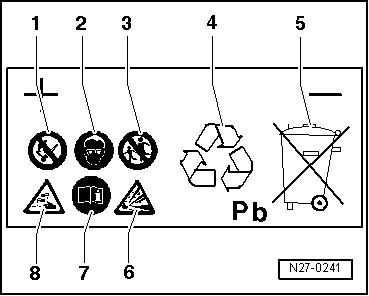| Explanatory notes on battery symbols |
| 1 - | Fires, sparks, naked flames and smoking are prohibited when handling batteries. Avoid sparks and static discharge when handling wires and electrical equipment. To avoid short circuits, never place tools on the battery. |
| 2 - | Wear eye protection when working on the battery. |
| 3 - | Keep children away from acid and batteries. |
| 4 - | Disposal: Old batteries are hazardous waste. They are only to be disposed of at an official collection point; all legal requirements must be observed. |
| 5 - | Do not dispose of old batteries with household waste. |
| 6 - | There is a risk of explosion when handling batteries. A highly explosive gas mixture is given off when batteries are under charge. |
| 7 - | Observe the instructions on the battery, in the Workshop Manual „Electrical system; General information“ and in the Owner's Manual. |
| 8 - | Danger of acid burns: Electrolyte is highly corrosive; protective gloves and eye protection should therefore always be worn when working on the battery. Do NOT tilt the battery as electrolyte can leak out of the gas vents. |

WARNING | Risk of injury due to electrolyte. |
| t
| Can cause severe injury to the eyes, skin and mucous membranes. |
| t
| Inhalation can damage the respiratory system. |
| t
| Swallowing is harmful to the digestive system. |
| t
| First aid: Rinse eyes and immediately consult first aid station or inform doctor. |
| t
| Never tilt battery. Acid can leak out of the gas vents. |
| t
| Soak up spilt electrolyte with binding agent and neutralise any residual electrolyte. Use e.g. soap solution for neutralising. |
| t
| Never allow electrolyte to come into contact with hands. |
| t
| Avoid contact with skin. |
| t
| Never touch mouth, nose or eyes with soiled hands. |
| t
| Immediately change any clothing affected by electrolyte and place in water if necessary. |
| t
| Do not eat, drink or store foodstuffs at workplace. |
| t
| Wash thoroughly before breaks and on completion of work. |
|

WARNING | Wear eye protection and protective clothing to reduce the risk of injury. |
| t
| Wear safety goggles and an acid-resistant apron or alternatively electrolyte-proof overalls. |
| t
| Wear electrolyte-proof gloves. |
|

WARNING | Risk of explosion due to gas produced when charging battery. |
| t
| The gas given off during charging and sometimes emitted by the battery at rest even after charging is explosive. In the worst case, improper handling of the battery can lead to explosion caused by escaping gas. |
| t
| Smoking, naked flames and sparks (caused by grinding, welding or cutting) are prohibited when working in the vicinity of the battery. |
| t
| Take care to avoid short circuits when handling wires and electrical equipment. Never place tools on the battery. |
| t
| To avoid sparks as a result of electrostatic discharge, always touch the vehicle body before handling the battery. |
|

WARNING | t
| If the display is colourless or light yellow on batteries with „magic eye“, do not check or charge the battery. Do NOT boost start the vehicle. There is a risk of explosion when checking or charging the battery or boost starting the vehicle. The battery must be renewed. |
| t
| Old batteries (in use for 6 months or more) must be treated with an anti-static spray (currently „Neostatic Antistatikum HB 155“) prior to handling. |
| t
| Sealing plugs of batteries which are not maintenance-free must be firmly screwed in when charging. |
| t
| Charging of batteries removed from the vehicle is only permitted in vented cubicles with extraction system. |
| t
| After charging, the battery must be left in the charging area with extraction system for an appropriate length of time. |
| t
| Only work on batteries in suitable, well ventilated areas. |
| t
| Batteries must always be transported in conductive metal containers. |
| t
| Do not use electrostatically chargeable materials for securing purposes. |
|

WARNING | Risk of damage to vehicle. |
| Escaping electrolyte could cause acid corrosion and damage to safety-relevant vehicle components. |
|

WARNING | Risk of environmental pollution. |
| t
| Old batteries are hazardous waste. They contain toxic lead (Pb) and sulphuric acid. |
| t
| Observe disposal regulations. Old batteries should only be disposed of in appropriate containers at an official collection point. |
|
|
|

|

